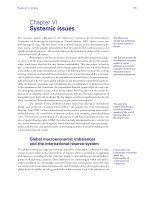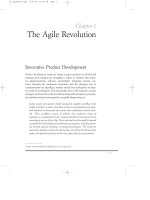PETROLEUM DEVELOPMENT GEOLOGY RESERVES ESTIMATE
Bạn đang xem bản rút gọn của tài liệu. Xem và tải ngay bản đầy đủ của tài liệu tại đây (1.16 MB, 35 trang )
• The most important role of a DG is to:
– estimate the oil and gas reserves that may
be discovered in a particular venture.
– keep track of the reserves in all past
ventures.
1. Educated Guess and/or Comparison
with nearby production.
2. Static Reserves Estimates
Ü
Volumetric Calculations
3. Dynamic Reserves Estimates
Ü
Ü
Ü
Decline Curve Analysis
Material balance calculations
Reservoir Simulation
• Consider a region where production is from a
highly fractured tight formation or where
poroperm heterogeneity is unpredictable.
• Volumetric calculations are largely
meaningless.
• A way to estimate potential production from
a well is to consider those nearby.
• Generally, such a wildcat well will not
perform better than the nearest wells: best to
estimate cautiously
• Most accurate and widely used methods of reserves
estimation.
• Carried out by geologists as they are based on
geological structure and isopach maps.
• Rock volumes are established that are assumed to
contain hydrocarbons (e.g. seismic bright spot).
• Can be a simple volume calculation or a complex net
gas or net oil isopach approach, determined by
structure contours modified by fluid contacts and net
isopachs (net reservoir thickness map).
• Accuracy of volumetrics depends on data for porosity,
saturation, net thickness, areal extent, formation
volume factor, integrity of those data within a reservoir.
Volumetric Method
• RR = 7758 x A.t x φ(1 – Sw) x FVF x RF
•
Amount of oil in reservoir
̇ RR
̇ 7758
=
=
̇
̇
̇
̇
̇
=
=
=
=
=
A
t
φ
(1-Sw)
FVF
̇ Bo/Bg
̇ RF
•
Amount of recoverable oil
Recoverable Reserves
conversion from acreft to barrels (if vol. in
m3. this conversion number is eliminated)
area of porous rock, acre
thickness in feet
porosity,%
water saturation of reservoir
Formation Volume Factor (1/Bo & 1/Bg)
å reservoir volume / surface volume (vr / vs )
=
Recovery Factor
• Most rock volumes established through use of
net gas and net oil isopachs (net pay map).
• Constructed from superimposing of net isopach
map and structure contour maps then cut
(reduced) it with well defined OWC and/or GOC.
• Calculate the volume of net pay map by
planimeter (or digitizer table) and/or grid square
counting
HORIZON MAP
(Superimposed Structure and Net Isopach Maps)
0m
5m
10 m
15 m
10 m
5m
0m
NET PAY MAP
Rock Volume Calculations
2 methods :
1. PYRAMID
2. TRAPEZOIDS
A
h
n
t
:
:
:
:
area, m2 or acre
isopach/contour interval, m or ft
contour number (0 å n)
avg. thickness above the top of max. thickness
RF
Recovery Factor
• Usually RF determination is carried out by
Reservoir Engineer.
• Mainly based on the reservoir drive, rock
properties and fluid properties.
• For oil with effective water drive the
primary recoveries are in 25 – 40 % range
(max. 75%).
• For gas with gravity drainage, water drive
and depletion drive can provide RF > 80%.
Drive Mechanism
Solution-gas drive
Gas-cap drive
Water drive
Gravity-drainage
drive
Drive Mechanism
Volumetric reservoir
(Gas expansion drive)
Water drive
Average Oil Recovery
Factors,
% of OOIP
Range
Average
5 - 30
15
15 - 50
30
30 - 60
40
16 - 85
50
Average Gas Recovery
Factors,
% of OGIP
Range
Average
70 - 90
80
35 - 65
50
Decline Curve Analysis
(Reservoir Engineer’s jobs)
• After wells have been producing for a while:
– The rate of production is graphed
– Generally 6 months – 1 year after start of
production
• Good reserves estimates can be derived.
Often compared with volumetric technique
results.
• Can be done by well, by a group of well, by
block, by reservoir, by field
Decline Analysis Results
• Determine remaining recoverable reserves
under natural depletion rate.
• To forecast production under existing
conditions
• Limitation:
– The degree of the accuracy is depend on the
reliability of the production data.
Production Plots
1. A plot of log(q) vs t is
p
p
Linear if decline is exponential
Concave upward if decline is hyperbolic (n>0) or harmonic
2. A plot of q vs Np is
p
p
Linear if decline is exponential
Concave upward if decline is hyperbolic(n>0) or harmonic
3. A plot of log(q) vs Np is
p
p
p
Linear if decline is harmonic
Concave downward if decline is hyperbolic (n<1) or exponential
Concave upward if decline is hyperbolic with n>1.
4. A plot of 1/q vs t is
p
p
p
Linear if decline is harmonic
Concave downward if decline is hyperbolic (n<1) or exponential
Concave upward if decline is hyperbolic with n>1.
Example. Exponential decline
Rate, stb/d
.
10000
q = 6049.1e
-0.0524 t
1000
Slope=-D 1/quarter year
100
0
10
20
30
40
time (quarter year)
50
60
Example. Rate decline with production
7000
6000
q = -0.4301Np + 5768.7
q stb/d
5000
4000
Reserves
3000
2000
q abondonment
1000
0
0
2000
4000
6000
8000
10000
Cum. prod, MSTB
12000
14000
12000
40
Rate (stb/d)
30
8000
25
6000
20
15
4000
10
2000
5
0
0
0
2
4
6
8
Time (years)
10
12
14
16
Cum. Production (MMstb)
35
10000
Hyperbolic Decline curve
10000
9000
8000
q STB/D
7000
6000
5000
4000
3000
2000
1000
0
0
50
100
150
200
days
250
300
350
MATERIAL BALANCE
of a Petroleum Reservoir
(Mostly carried out by Reservoir Engineer)
General Concept of Material Balance.
a. Initial reservoir conditions.
From: Petroleum Reservoir Engineering
— Amyx, Bass, and Whiting (1960).
b. Conditions after producing Np STB of oil,
and Gp SCF of gas, and Wp STB of water.
Material Balance: Key Issues
̈
̈
̈
̈
Must have accurate production measurements (oil, water, gas).
Estimates of average reservoir pressure (from pressure tests).
Suites of PVT data (oil, gas, water).
Reservoir properties: saturations, formation compressibility, etc.









